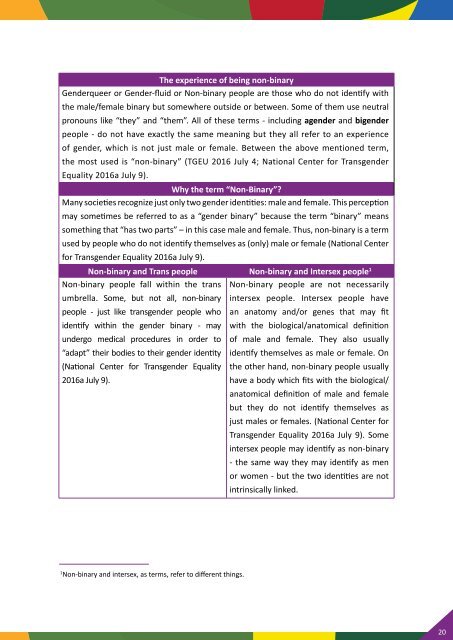Media Reporting and Reference Guide on LGBT Issues
Create successful ePaper yourself
Turn your PDF publications into a flip-book with our unique Google optimized e-Paper software.
The experience of being n<strong>on</strong>-binary<br />
Genderqueer or Gender-fluid or N<strong>on</strong>-binary people are those who do not identify with<br />
the male/female binary but somewhere outside or between. Some of them use neutral<br />
pr<strong>on</strong>ouns like “they” <str<strong>on</strong>g>and</str<strong>on</strong>g> “them”. All of these terms - including agender <str<strong>on</strong>g>and</str<strong>on</strong>g> bigender<br />
people - do not have exactly the same meaning but they all refer to an experience<br />
of gender, which is not just male or female. Between the above menti<strong>on</strong>ed term,<br />
the most used is “n<strong>on</strong>-binary” (TGEU 2016 July 4; Nati<strong>on</strong>al Center for Transgender<br />
Equality 2016a July 9).<br />
Why the term “N<strong>on</strong>-Binary”?<br />
Many societies recognize just <strong>on</strong>ly two gender identities: male <str<strong>on</strong>g>and</str<strong>on</strong>g> female. This percepti<strong>on</strong><br />
may sometimes be referred to as a “gender binary” because the term “binary” means<br />
something that “has two parts” – in this case male <str<strong>on</strong>g>and</str<strong>on</strong>g> female. Thus, n<strong>on</strong>-binary is a term<br />
used by people who do not identify themselves as (<strong>on</strong>ly) male or female (Nati<strong>on</strong>al Center<br />
for Transgender Equality 2016a July 9).<br />
N<strong>on</strong>-binary <str<strong>on</strong>g>and</str<strong>on</strong>g> Trans people N<strong>on</strong>-binary <str<strong>on</strong>g>and</str<strong>on</strong>g> Intersex people 1<br />
N<strong>on</strong>-binary people fall within the trans N<strong>on</strong>-binary people are not necessarily<br />
umbrella. Some, but not all, n<strong>on</strong>-binary<br />
people - just like transgender people who<br />
identify within the gender binary - may<br />
undergo medical procedures in order to<br />
“adapt” their bodies to their gender identity<br />
(Nati<strong>on</strong>al Center for Transgender Equality<br />
2016a July 9).<br />
intersex people. Intersex people have<br />
an anatomy <str<strong>on</strong>g>and</str<strong>on</strong>g>/or genes that may fit<br />
with the biological/anatomical definiti<strong>on</strong><br />
of male <str<strong>on</strong>g>and</str<strong>on</strong>g> female. They also usually<br />
identify themselves as male or female. On<br />
the other h<str<strong>on</strong>g>and</str<strong>on</strong>g>, n<strong>on</strong>-binary people usually<br />
have a body which fits with the biological/<br />
anatomical definiti<strong>on</strong> of male <str<strong>on</strong>g>and</str<strong>on</strong>g> female<br />
but they do not identify themselves as<br />
just males or females. (Nati<strong>on</strong>al Center for<br />
Transgender Equality 2016a July 9). Some<br />
intersex people may identify as n<strong>on</strong>-binary<br />
- the same way they may identify as men<br />
or women - but the two identities are not<br />
intrinsically linked.<br />
1<br />
N<strong>on</strong>-binary <str<strong>on</strong>g>and</str<strong>on</strong>g> intersex, as terms, refer to different things.<br />
20


